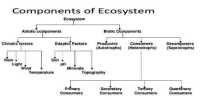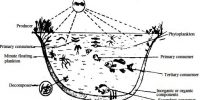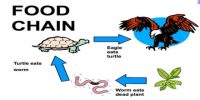We have learnt before that the non-living elements influence the living elements. Inorganic, organic and physical components are included in non-living components.
- Inorganic components: Water and mineral salts are inorganic components of eco-system. In addition to these, there are other gaseous elements like O2 (oxygen), N2 (nitrogen), CO2 (carbon dioxide) etc., which are necessary for the nutrition of the plants and respiration of organisms.
- Organic components: It is the rotten parts of the dead body of plants and animals. The dead body of plants and animals after being decomposed forms urea and humus. These constitute the organic elements of the soil. Saprophytic fungus and bacteria acting on dead plants and animals from the organic components. Some of its parts are converted into inorganic salts. These inorganic salts are taken as nutrients by the green plants. Now you have understood, how the organic components maintain the link between the biotic and abiotic parts of the environment.
- Physical components: The environment is largely dependent on certain physical factors. They are:
- Climate: The climate of a particular environment depends on rainfall, air movement, temperature, humidity, amount of sunlight, snow fall etc.
- Soil factor: Condition of soil in any place influences the animals and plants living there.
Living components of Ecology
Every organism is a part of the eco-system. In eco-stem the non-living and living components are interdependent. The absence of one affects the other in maintaining their natural activities. The habits of plants influence the animals characters of eco-system. Every living being takes food for its physical growth, reproduction and existence. Every organism gets energy from food. We have learnt before that the source of energy flowing in the biotic community is the sun.














